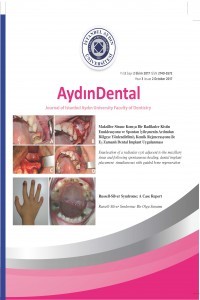Endodontic Systems Working With Reciprocal Movements For Instrumentation of Root Canals
Kök kanallarının şekillendirilmesi, Ni-Ti döner alet sistemleri, endodontik resiprokal sistemler
Endodontic Systems Working With Reciprocal Movements For Instrumentation of Root Canals
___
- Byström A, Sundqvist G. Bacteriologic evaluation of the efficacy of mechanical root canal instrumentation in endodontic therapy. Scand J Dent Res 1981; 89: 321-8.
- Peters LB, Wesselink PR, Moorer WR. The fate and the role of bacteria left in root dentinal tubules. J Endod 1995; 28: 95-9.
- Schilder H. Cleaning and shaping the root canal. Dent Clin North Am 1974; 18: 269-96.
- Zehnder M. Root canal irrigants. J Endodon 2006; 32: 389-98.
- Peters OA. Current challenges and concepts in the preparation of root canal systems: A review. J Endod 2004; 30: 559-67.
- Sahni PS, Brown CE, Legan JJ, Moore BK, Vail MM. Comparison of rotary instrumentation and continuous wave obturation to reciprocating instrumentation and single cone obturation with a hydrophilic sealer.J Endod 2008; 34: 99-101.
- Rödig T, Hülsmann M, Mühge M, Schäfers F. Quality of preparation of oval distal root canals in mandibular molars using nickel-titanium instruments. Int Endod J 2002; 35: 919-28.
- Franco V, Fabiani C, Taschieri S, Malentacca A, Bortolin M, Del Fabbro M. Investigation on the shaping ability of nickel-titanium files when used with a reciprocating motion. J Endod 2011; 37: 1398-1401.
- De-Deus G, Barino B, Zamolyi RQ, Souza E, Junior AF, Fidel S, Fidel RAS. Suboptimal debridement quality produced by the single-file F2 ProTaper technique in oval-shaped canals. J Endod 2010; 36: 1897-1900.
- Rhodes SC, Hülsmann M, McNeal SF, Beck P, Eleazer PD. Comparison of root canal preparation using reciprocating Safesiders stainless steel and Vortex nickel-titanium instruments. Oral Surg Oral Med Oral Pathol Oral Radiol Endod 2011; 111: 659-67.
- Lopez FU, Fachin EV, Fontanella VRC, Barletta FB, Reis MV, Grecca FS. Apical transportation: a comparative evaluation of three root canal instrumentation techniques with three different apical diameters. J Endod 2008; 34: 1545-8.
- Yared G. Canal preparation using only one Ni-Ti rotary instrument: preliminary observations. Int Endod J 2008; 41: 339-44.
- You SY, Bae KS, Baek SH, Kum KY, Shon WJ, Lee W. Lifespan of one nickel-titanium rotary file with reciprocating motion in curved canals.J Endod 2010; 36: 1991-4.
- De-Deus G, Brandao MC, Barino B, Di Giorgi K, Fidel RAS, Luna AS. Assessement of apically extruded debris produced by the single-file Protaper F2 technique under reciprocating movement. Oral Surg Oral Med Oral Pathol Oral Radiol Endod 2010; 110: 390-4.
- De-Deus G, Moreira EJL, Lopes HP, Elias N. Extended cyclic fatique life of F2 Protaper instruments used in reciprocating movement. Int Endod J 2010; 43: 1063-8.
- Paqué F, Zehnder M, De-Deus G. Microtomography-based comparison of reciprocating single-file F2 ProTaper technique versus rotary full sequence. J Endod 2011; 37: 1394-7.
- You SY, Kim HC, Bae KS, Baek SH, Kum KY, Lee W. Shaping ability of reciprocating motion in curved root canals: a comparative study with micro-computed tomography.J Endod 2011, 37: 1296-300.
- Wan J, Rasimick BJ, Musikant BL, Deutsch AS. Cutting efficiency of 3 different instrument designs used in reciprocation.Oral Surg Oral Med Oral Pathol Oral Radiol Endod 2010; 109: 82-5.
- Kfir A, Tsesis I, Yakirevich E, Matalon S, Abramovitz I. The efficacy of five techniques for removing root filling material: microscopic versus radiographic evaluation. Int Endod J 2012; 45: 35-41.
- Berutti E, Chiandussi G, Paolina DS, Scotti N, Cantotore G, Castellucci A, Pasqualini D. Effect of canal length and curvature on working length alteration with waveone reciprocating files. J Endod 2011; 37: 1687-90.
- Barletta FB, Reis M, Wagner M, Borges JC, Dall’Agnol C. Computed tomography assessment of three techniques for removal of filling material. Aust Endod J, 2008; 34: 101-5.
- Eid GEH, Amin SAW. Changes in diameter cross-sectional area and extent of canal-wall touching on using 3 instrumentation techniques in long-oval canals. Oral Surg Oral Med Oral Pathol Oral Radiol Endod, 2011; x:1-8.
- Karataş E, Gündüz HA, Kırıcı DÖ, Arslan H, Topçu MÇ, Yeter KY. Dentinal crack formation during root canal preparations by the twisted file adaptive, ProTaper Next, ProTaper Universal and WaveOne instruments. J Endod 2015; 41:261-4.
- Higuera O, Plotino G, Tocci L, Carrillo G, Gambarini G, Jaramillo DE. Cyclic fatigue resistance of 3 different nickel-titanium reciprocating instruments in artificial canals. J Endod 2015;41:913-5.
- Karataş E, Gültekin E, Arslan H, Kirici DÖ, Alsancak M, Topçu MÇ. Evaluation of instrumentation systems in reducing E. faecalis from root canals: TF adaptive and ProTaper next versus single file systems. Int J Artif Organs 2015 Mar;38(3):161-4.
- Priya NT, Chandrasekhar V, Anita S, Tummala M, Raj TB, Badami V, Kumar P, Soujanya E. J Clin Diagn Res 2014;8: 70-2.
- ISSN: 2149-5572
- Yayın Aralığı: Yılda 3 Sayı
- Başlangıç: 2015
- Yayıncı: İstanbul Aydın Üniversitesi
Rubberdam Clamp Ingestion During Root Canal Treatment: A
Ece ÇALIŞKAN, Hafiz Hande GÜRBÜZ, Rüştü DAĞLAROĞLU, Raif ERİŞEN
Eroziv Lezyonlarin Direkt Kompozit Lamina Venerler ile Minimal İnvaziv Restorasyonu: Olgu
Rezin Nano Seramik Endokron: Post-Kor Destekli Kron Restorasyonlara Bir Alternatif
İşıl Kaya BÜYÜKBAYRAM, Gülce ALP
Diş Beyazlatma Ürünlerinin Dentin Mikrosertliğine Etkileri
Endodontic Systems Working With Reciprocal Movements For Instrumentation of Root Canals
Lokalize Dişeti Çekilmesine Multidisipliner Yaklaşım: Bir Olgu Sunumu
Burcu KARADUMAN, Cenker KOYUNCUOĞLU, Sevda ATALAY, Ece ÇALIŞKAN, Nurcan TEZCİ, Sabri Hasan MERİÇ
Yumuşak Dokunun Estetik Tedavi Planındaki Yeri
Buket AYNA, Emrah AYNA, Sema ÇELENK, Behiye BOLGÜL, Ersin UYSAL
